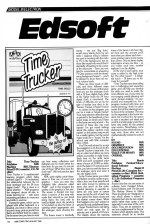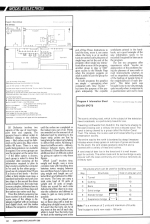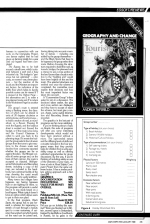
A&B Computing
 1st January 1986
1st January 1986
Categories: Review: Software
Author: Des Thomas
Publisher: Fernleaf
Machine: BBC Model B
Published in A&B Computing 3.01
Roads (Fernleaf)
Roads is the first of a new series of software from Fernleaf Educational Software, with The Sea and The Railway Drama to follow. These programs are designed in a way which allows a school to integrate them into its own organisation rather than cause a new approach to any area of the curriculum. They are an extension to, and not a replacement for, the curriculum which already exists. This extension should be to involve pupils in further work in the development of thinking skills through such processes as decision making, forming and testing hypotheses and the use of strategies to resolve situations." Certainly, the titles will be familiar ones to those who use a project/topic approach and teachers apprehensive of using the computer will find the format and the approach used reassuring - there's no doubt in my mind that the computer, with the right software, can open up new horizons in topic work.
In the Roads suite, two aspects have been considered - the building of roads and their use. The first two programs (for use with 8+ to 12+ age groups) are concerned with using roads: planning deliveries/pickups, routes taken and optimum use of vehicle and manpower; the last two (for use with 10-12+ age group) give the users the opportunity to construct roads - a bypass around a town and improving a motorway link road - taking social and ecological issues and financial constraints into account.
I've received two other programs over the past months with the same "theme" as the first two: Quick Cartage Company from John Wiley and Time Trucker from ASK. (A&B have their own version, Delivery available from the Software Sale). Interestingly, they all have a different emphasis: QCC is considered a full-scale simulation with good screen maps and concentrates on the concepts of distance and scale with random elements thrown in, while Time Trucker "turns time telling into a challenging and rewarding game". None of the razzmatazz with Fernleaf - "The programs are too much of a simplification to be called simulations, but they do present starting points for the consideration of the problems facing road transport firms".
Oil Deliveries
Oil Deliveries involves two aspects of the use of road transport: time and capacity. The group(s) have to deliver orders to different villages in the delivery area - Red orders must be delivered on the same day, Blue orders within 48 hours. There is a very useful demonstration run available if required. One or two groups can use the program at the same time - if the latter option is chosen, each group is asked to leave the computer after receiving all the information required to plan its day's route to enable the computer to be used by the other group - good use of computer time! There is a choice of two levels - the first offers a fairly simple route map, a standard size tanker and work over two days; in the second the driver works longer hours, the route map is more complex, deliveries have to be worked out over three days and the tanker size varies each day.
Once the delivery sequence has been worked out and entered, the route map of the village is displayed, together with an analogue and digital clock, and the tanker follows the sequence of deliveries until the orders are completed or the tanker runs out of oil. Points are awarded on the amount of oil delivered and by returning to the depot early; points are lost by being late at the depot or by failing to deliver Red orders. All timing is based on half-hour units - delivery, distance between towns, driver's lunchbreak. I'd have liked to see an additional level of difficulty added by giving an option to vary these figures.
Which Load?
Which Load? involves time, weight and length, and uses a more complex map with travelling time between towns varying between two and three hours. Crates of varying weight and length are collected from and delivered to different towns. The lorry can carry a total crate load of 15 units of weight and 10 units of length. Points are scored for each crate delivered and the object is to organise the collection and delivery of crates to gain as many points as possible.
The game can be played over two or three days with a total travelling time of eight hours per day. In Level One, the lorry can be at any town at the end of each day, while in Level Two the lorry must be back at the starting town at the end of Day Three. Instructions to load the lorry, move it, see crates where the lorry is or at another town are carried out by the press of single keys and at the end of the program other single key instructions allow a rerun of the program, another group to play or Shift gives access to the Results Page when the program suggests an adult is asked to join the group for discussion.
In both programs, the graphics are simple - uninspiring when compared with Time Trucker - but serve the purpose of the program adequately. The copiable worksheets printed in the handbook, set a good example of the way information needs to be recorded if required for later use in the program.
The last two programs offer experiences which "involve an appreciation of the problems facing the planners of new roads or road improvements schemes as well as empathetic understanding of the feelings of people living in the neighbourhood of such projects". This latter point was brought home to me very strongly quite recently when, in response to a questionnaire sent out to local farmers in connection with our work on the Domesday Project; one farmer replied that he had given up farming totally for a year until our bypass had been completed.
The Bypass
The Bypass has to be built around a small town, which is situated between a port and a busy industrial city. The budget is "generous but not unlimited" - obviously, we weren't very clever planners - but the reaction of the locals and the Minister are important factors. An indication of the traffic flow which helps to decide possible routes can be viewed if T is pressed at the Option Page - the alternatives are E to enter a pre-planned route and P to return to the Worksheet Page for another group.
The group's route is entered using a flashing arrow, the direction of which can be altered in units of 30 degrees clockwise or anticlockwise, and function keys - to build a section of road, a roundabout, or a flyover. Pressing f6 ends the Bypass, and the balance sheet is worked out. Exceed the budget, or if the route is too long, and the Council Chairman is called to send you back to the planning stage. If it meets the budget, the group selects four of seven groups from the town to give reactions to the chosen route and decides from comments reported whether the groups are for or against the plan. The Minister consults all seven groups and, on the basis of their opinion, the route is accepted or rejected. Well-presented Information and Recording sheets, including a copy of the map, are included in the handbook, but a printout facility of the map showing the route would have been a very useful addition.
Many towns and villages have bypasses, are having bypasses built or are fighting for them, so this program will provide a useful lead in to any study based on a local bypass. What a pity it doesn't have an option which allows users to put in their own plan!
Black Spots
In the final program, Black Spots, the group has to put forward a scheme for improving a stretch of road through a beauty spot to a new motorway. A surveyor has worked out which points on the road can be joined and, having taken into account a number of factors - including one added by the group themselves - and the Black Spots that have to be bypassed, the group select their route. Before choosing the structures required to build the road, e.g. tunnels, bridges, the planners have a chance to see a cross-section of the land (some idea of scale in relation to the "building unit" would have been helpful on this and the map). The selected structures are entered and, once the scheme is completed, the committee must explain their decisions and how the most important factor was taken into account.
A "Conservation Group" is then asked to join in a discussion. The decisions taken earlier, the plan and cross-section are displayed, and they have to accept or reject the scheme, but must give a reason. Again, some useful Information and Recording Sheets are provided.
The graphics in the last pair of programs are far more satisfying.
If you're thinking about a topic on Roads, this suite of programs will offer you some interesting developments which would not have been practical without a micro. The open-ended nature and the differing levels of skills and concepts included in the four programs mean that they provide tasks for children from a wide age/ability range as well as offering unlimited opportunities for group discussions. By the way, if you're thinking of including safety as one of the elements of your topic, do have a look at Road Safety Computer Project from the same software house. It has a similar problem-solving approach and is first class.
Other BBC Model B Game Reviews By Des Thomas
This article was converted to a web page from the following pages of A&B Computing 3.01.
Scores
BBC Model B Version| Graphics | 75% |
| Documentation | 90% |
| Educational Value | 90% |
| Value For Money | 80% |
| Overall | 85% |












